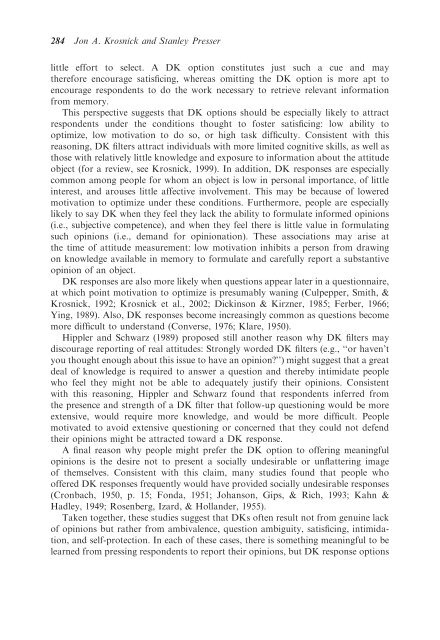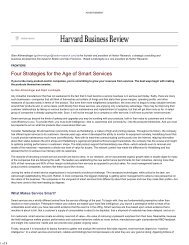Question and Questionnaire Design - Stanford University
Question and Questionnaire Design - Stanford University
Question and Questionnaire Design - Stanford University
You also want an ePaper? Increase the reach of your titles
YUMPU automatically turns print PDFs into web optimized ePapers that Google loves.
284 Jon A. Krosnick <strong>and</strong> Stanley Presserlittle effort to select. A DK option constitutes just such a cue <strong>and</strong> maytherefore encourage satisficing, whereas omitting the DK option is more apt toencourage respondents to do the work necessary to retrieve relevant informationfrom memory.This perspective suggests that DK options should be especially likely to attractrespondents under the conditions thought to foster satisficing: low ability tooptimize, low motivation to do so, or high task difficulty. Consistent with thisreasoning, DK filters attract individuals with more limited cognitive skills, as well asthose with relatively little knowledge <strong>and</strong> exposure to information about the attitudeobject (for a review, see Krosnick, 1999). In addition, DK responses are especiallycommon among people for whom an object is low in personal importance, of littleinterest, <strong>and</strong> arouses little affective involvement. This may be because of loweredmotivation to optimize under these conditions. Furthermore, people are especiallylikely to say DK when they feel they lack the ability to formulate informed opinions(i.e., subjective competence), <strong>and</strong> when they feel there is little value in formulatingsuch opinions (i.e., dem<strong>and</strong> for opinionation). These associations may arise atthe time of attitude measurement: low motivation inhibits a person from drawingon knowledge available in memory to formulate <strong>and</strong> carefully report a substantiveopinion of an object.DK responses are also more likely when questions appear later in a questionnaire,at which point motivation to optimize is presumably waning (Culpepper, Smith, &Krosnick, 1992; Krosnick et al., 2002; Dickinson & Kirzner, 1985; Ferber, 1966;Ying, 1989). Also, DK responses become increasingly common as questions becomemore difficult to underst<strong>and</strong> (Converse, 1976; Klare, 1950).Hippler <strong>and</strong> Schwarz (1989) proposed still another reason why DK filters maydiscourage reporting of real attitudes: Strongly worded DK filters (e.g., ‘‘or haven’tyou thought enough about this issue to have an opinion?’’) might suggest that a greatdeal of knowledge is required to answer a question <strong>and</strong> thereby intimidate peoplewho feel they might not be able to adequately justify their opinions. Consistentwith this reasoning, Hippler <strong>and</strong> Schwarz found that respondents inferred fromthe presence <strong>and</strong> strength of a DK filter that follow-up questioning would be moreextensive, would require more knowledge, <strong>and</strong> would be more difficult. Peoplemotivated to avoid extensive questioning or concerned that they could not defendtheir opinions might be attracted toward a DK response.A final reason why people might prefer the DK option to offering meaningfulopinions is the desire not to present a socially undesirable or unflattering imageof themselves. Consistent with this claim, many studies found that people whooffered DK responses frequently would have provided socially undesirable responses(Cronbach, 1950, p. 15; Fonda, 1951; Johanson, Gips, & Rich, 1993; Kahn &Hadley, 1949; Rosenberg, Izard, & Holl<strong>and</strong>er, 1955).Taken together, these studies suggest that DKs often result not from genuine lackof opinions but rather from ambivalence, question ambiguity, satisficing, intimidation,<strong>and</strong> self-protection. In each of these cases, there is something meaningful to belearned from pressing respondents to report their opinions, but DK response options
















